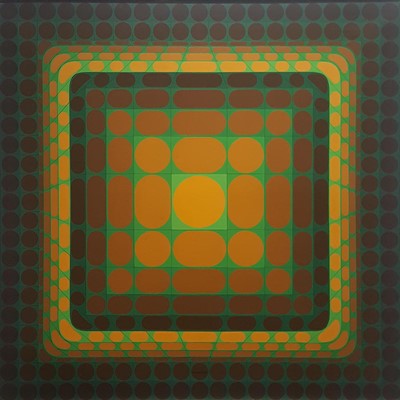Victor Vasarely, original name Gyözö Vásárhelyi, was born in Pécs, Hungary in 1906.
In 1927, after studying medicine for a couple of years at the University of Budapest, he decided to devote himself to art and began his artistic training at a private drawing school in Budapest.
In 1929 he enrolled in Mühely (German ‘workshop’), a school founded in Dessau by Sándor Bortnyik, that taught the ideas of the Bauhaus. In this period he comes into contact with Constructivism and abstract art. After leaving Hungary, in 1930 he settled in Paris, where he began working successfully as a graphic designer and systematically explored the optical and emotional scope of the different graphic techniques.
This led to his understanding in 1947 that geometric forms could evoke a sensory perception conveying new ideas of space, matter and energy. He developed his own geometric form of abstraction, which he varied to create different optical patterns with a kinetic effect. The artist makes a grid in which he arranges geometric forms in brilliant colours in such a way that the eye perceives a fluctuating movement. This was a major contribution to the development of Op Art. The decoration of Caracas University in 1954 was the beginning of Vasarely’s active support of art in public spaces. He designed murals of metal and ceramic, mainly for buildings in France. He exhibited works regularly at the documenta in Kassel between 1955 and 1968. The official spiral-shaped logo of the 20th Olympic games in Munich was designed by Vasarely.
The Vasarely Museum in the artist’s birth-town Pécs was opened in 1976, followed by the opening of a second museum in Zichy Palace in Budapest in 1987. The Vasarely Foundation opened in Aix-en-Provence in 1976 had to be closed soon after his death, but the care for the artist’s appreciated image world was secured by the refurbishment of Vasarely’s estate by his daughter Michelle.
Vasarely died in Paris in 1997
